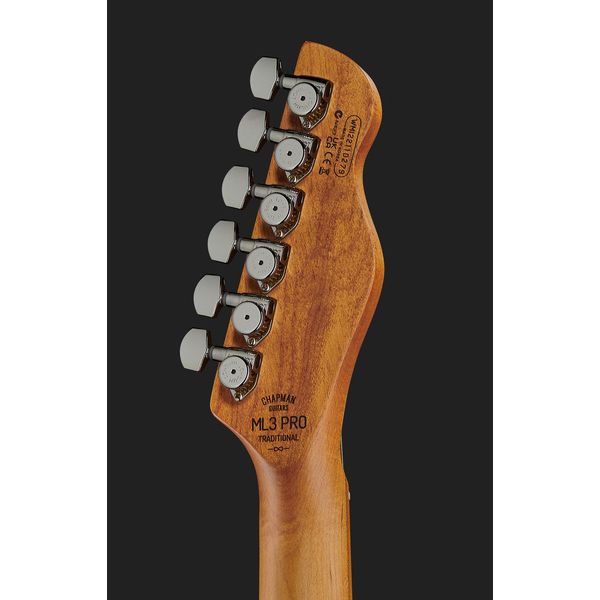Chapman Guitars ML3 Pro Trad Frost Green
Le caratteristiche della chitarra Chapman Guitars ML3 Pro Trad Frost Green :
Body: A;der
Bolt-on neck: Roasted maple
Fingerboard: Roasted maple
Scale: 648 mm (25.5″)
Fingerboard radius: 250 mm
Nut width: 42 mm
22 Jumbo stainless steel frets
Pickups: 2 Seymour Duncan Hot Tele single coils
Volume and tone controls
3-Way switch
Chapman String Through T-style bridge with brass saddles
Open Hipshot Grip-Lock machine heads
Chrome hardware
Colour: Frost Green Metallic Gloss
In catalogo dal Febbraio 2023
Numero di articolo 525954
Unitá incluse 1 Pezzo
Colour Green
Pickups SS
Fretboard Maple
Tremolo
Body Alder
Top
Neck Maple
Frets 22
Scale 648 mm
Incl. Case No
Incl. Bag No
Le pratiche di giunzione del corpo della chitarra (Chapman Guitars ML3 Pro Trad Frost Green)
Il modo in cui il manico è attaccato al corpo della chitarra elettrica ha un ruolo fondamentale nel suono dello strumento. In realtà, ci sono 3 tecniche principali di giunzione al corpo della chitarra:
- il manico incollato chiamato set neck
- il manico conduttore
- il manico avvitato chiamato bolt-on neck
Il manico conduttore (neck-thru)
Questa pratica si rivela essere la più costosa.
Il manico va da un’estremità all’altra della chitarra e fa parte integrante del corpo.
Pertanto, offre una trasmissione ideale delle vibrazioni.
Il manico avvitato per chitarra elettrica
In origine utilizzato da Fender, questa pratica crea strumenti musicali kit che offrono diverse parti sostituibili.
Questa pratica di fissaggio conferisce brillantezza alla chitarra.
Il manico incollato
Popolare grazie al marchio Gibson, poi PRS, ottimizza la sostenibilità e il vibrato.
Quante corde? (Chapman Guitars ML3 Pro Trad Frost Green)
Le siano fatte di nichel o acciaio.
La chitarra elettrica a sei corde
Una chitarra elettrica a 6 corde ha 3 corde gravi e 3 corde acute.
La chitarra elettrica a dodici corde
La chitarra a 12 corde è stata utilizzata principalmente da alcune orchestre folk negli anni ’60.
La chitarra a 7 corde
La chitarra a sette corde è un modello di chitarra per i metallari. Inoltre, ci sono diversi tipi di chitarre jazz simili. Le corde di queste chitarre sono simili a quelle della chitarra elettrica a sei corde, ma hanno una corda in più che produce una nota più grave.
Tipo di pickup (Chapman Guitars ML3 Pro Trad Frost Green)
Quando si sceglie una chitarra elettrica, è anche consigliabile prestare attenzione ai pickup.
I pickup si distinguono per il loro avvolgimento.
E’ possibile distinguere:
- la chitarra con un pickup doppio bobinaggio, come la Gibson, suona con un volume di uscita più alto.
- la chitarra con un pickup singolo e doppio bobinaggio.
- la chitarra con un pickup singolo bobinaggio, come la Fender Telecaster, è preferibile per il rock, il blues o il country.
Come scegliere la tua chitarra elettrica? (Chapman Guitars ML3 Pro Trad Frost Green)
A causa del suo peso ridotto, la chitarra elettrica è perfetta per tutti i chitarristi.
È consigliata per molti stili musicali tra cui:
- rock
- blues
- funk
- metal
- jazz
Per scegliere la migliore, il musicista deve prendere in considerazione diversi criteri di selezione. In particolare:
- i corpi
- il numero di corde
- il legno.
Guitar Electric Neck Attributes (Chapman Guitars ML3 Pro Trad Frost Green)
The length of an electric guitar neck varies depending on the model. Although the distinction is not so distinctive, an effect on string play can be discerned.
Guitar Scale Length
The scale length is the vibrating distance of the strings between the bridge and the nut. This dimension affects both sound and playing comfort. Indeed, a smaller scale length will feel more flexible.
The two most common scale lengths are Fender Strat 25.50″ and Gibson 24.75″.
A Short-Scale Electric Guitar Neck
With less tension and greater flexibility in the strings, playing becomes easier, as with Les Paul guitars.
A Longer Neck
When the guitar neck is longer, like that of a Stratocaster or Ibanez, string tension increases and their vibration also increases.
Main Woods for Electric Guitars (Chapman Guitars ML3 Pro Trad Frost Green)
The woods used by most luthiers will determine the sound and resonance of the electric guitar.
Regarding the neck, the most common woods on the market are mahogany and maple.As for the fingerboard, it is usually made of:
- ebony
- maple
- rosewood
The choice of wood can potentially change the sound of an electric guitar easily.
Here are two widely used woods:
Mahogany
It offers a round, deep sound with strong sustain.
Rosewood
A dark wood with excellent density and hardness, it is chosen for making guitar fingerboards.
Guitar Bodies (Chapman Guitars ML3 Pro Trad Frost Green)
The type of resonant body has an impact on the sound of the guitar.
Solid Body
The very first solid body guitar was invented in the 1950s.
Semi-Hollow Body
It combines the effects of both hollow and solid bodies.
It provides a sound that approaches that of an acoustic guitar with more audible midrange and lower frequency.
Therefore, it is ideal for playing with a small amplifier.Hollow Body
Hollow body guitars are particularly used in jazz music styles.
This type of body produces sounds ideal for acoustic guitars.











